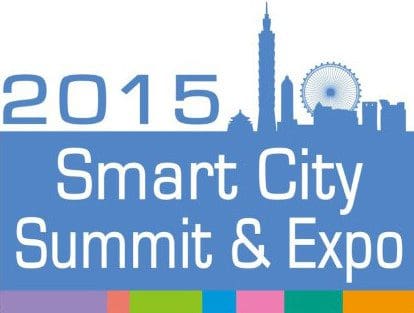
Around the globe, enthusiasm continues to grow for the many benefits of Smart City initiatives. Multiple domains—lighting, power, information sharing, among others—are converging and the same is taking place around many of connected applications and services. This exciting dynamic was clearly demonstrated at the recent Smart City Summit and Expo held Jan. 21-23 at the Taipei World Trade Center. Launched last year by Taipei Computer Association, with broad organizational support from industry and research institutions, this year’s event showed significant increases in participation and collaborative thought on enabling practical new applications and services. Advantech, Asus Cloud, Chunghwa Telecom, Industrial Technology Research Institute, and Tatung co-organized the event.
W. Y. Lin, President Tatung Co said, “As one of the main co-organizers of the Smart City Expo we believe that Smart Cities, in which lighting and energy use, transportation and parking infrastructure, and highly secure information processing and sharing contribute to greater productivity, efficiency, convenience, with appropriate privacy protections, is one of the key near-term opportunities for the Internet of Things (IoT). To realize this opportunity we need to build a thriving ecosystem and this event provided us with clear evidence that with our partners we have the right vision and are on the right track.”
Forum sponsors included Ericsson Taiwan, IBM Taiwan and STMicroelectronics, which also provided me the honor of opening a half-day forum on Smart Living Forum: Trends, Technologies and Applications, where I could relate a lot of the exciting developments we’re seeing today. We see Smart Cities driving IoT growth, where a convergence with Smart Homes, Smart Buildings, Smart Cars and Smart Me is pushing progress. One item on many minds, especially in scenarios where data is shared across multiple domains, was how to assure privacy and data security as we move towards an even more-connected world, the world in which traditional vertical models are transforming into models embracing horizontal platforms spanning across multiple domains.
As Chair of the IEEE Internet Initiative and the IEEE P2413 “Standard for an Architectural Framework for the IoT,” it was rewarding to hear the views of many like-minded individuals who are committed to bringing technology and policy leaders together to ensure that we put in place an environment where we build safe systems that protect data.
That was just one of many other topics in the special forum session detailing IEEE P2413 and the importance of establishing a standard for an architectural framework for the Internet of Things. This session led to some unique takeaways from the participants, which included Hitachi, Siemens, dZhON Pty Ltd, Huawei, Tatung and ARM. For instance, Mr. Ogura of Hitachi pointed out that standards for the IoT era should be based on the “change is the norm” concept (symbiotic autonomous decentralized concept) in order to respond to the adaptability and coexistence requirements.
According to Dr. Alan Pan, Chief Strategy Officer, Tatung Consumer Business Group. “It was a great pleasure to be a part of the panel discussing the architectural framework for the IoT. The discussion clearly showed that scalable and secure implementations of IoT can only be built on the solid foundation, and such foundation needs a solid framework. It is both exciting and encouraging to see world-leading companies working together to make this vision a reality.”
Huawei spoke to the evolving requirement to integrate broad cross industry and cross SDO collaboration in Smart Cities standards development and the importance of an adopted global cross domain integrating architecture framework, such as IEEE P2413, to ensure the long term viability of effective go-to-market deployments.
All in all, this session was truly informative and initially generated over 750 registrants. Due to space limitations at the venue, we could only host about 500 participants and the room was packed. That’s clearly an indication of the enormous interest and support for an overarching IoT standard and the enabling technologies that will also support the Smart City – especially one that is evolving quickly from one-off projects impacting single-function applications, such as street lighting or traffic flow, to large-scale, municipal capital investments integrating multiple city services and departments.
Visit the IEEE Standards Association Internet of Things webpage for more information on IoT related standards, projects and events.
Oleg Logvinov is the Director of Special Assignments in STMicroelectronics’ Industrial & Power Conversion Division. During the last 25 years Mr. Logvinov has held senior technical and executive management positions in the telecommunications and semiconductor industries. He serves on the IEEE Standards Association (IEEE SA) Corporate Advisory Group and the IEEE SA Standards Board. Mr. Logvinov also actively participates in IEEE standards development working groups focused on the IoT and communications technologies. He is chair of the IEEE P2413 Standard for an Architectural Framework for the Internet of Things Working Group. He is also chair of the IEEE Internet Initiative.

